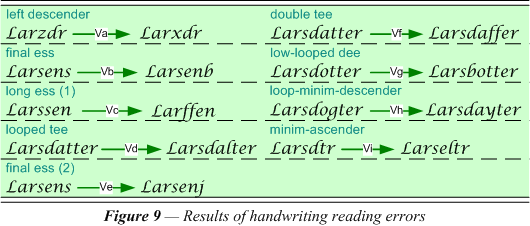
1.2 Misreading. In this case the clerk-extractor unintentionally creates a variant spelling by mistakingly reading a spelling inaccurately due to handwriting ambiguities. There are differences between the writing habits of the clerk-recorder trained in a former age and the clerk-extractor with a modern education. Hence, it is all too common for someone to misinterpret one or more letters when reading a name; the handwritten forms seem so similar and may even have be ambiguous when produced. One example, is found in the surname “Longhurst” which when sometimes written in certain 19th century Quaker records has been read as “Songhurst.” Similarly, the name “Lilly” on 1900 census records has been read as “Silly.” The source of this error, of course, is a wide variation in the way the different writers form the initial capital letter.

In this particular case the name “Songhurst” is not a valid surname, so the reading may be considered a variation of “Longhurst.” If someone is not familiar with the name, it is just as understandable that the reader may think that “Silly” could be a nickname. Sometimes basing the decision on the unusual occurrence of the name is not practical. Suppose someone writes “Daniel” and it is read and copied as “David” or vice versa.

In this case the “el” looks like a “d” that is not closed at the top and the “n” like a “v” because its shoulder is missing and its second minim is short or does not reach the line of writing. These are distinct names each having its own variants. Since misreading is relatively rare, it is probably most practical to allow this kind of variation to affect the match decision more indirectly than by making them have the same standard.

Other examples of misreading from the 1900 census include those where the strokes are indistinct. The name may be unfamiliar to some extractors, as when “Beus” was read as “Beris,” or it may be familiar, simply ambiguous, as when “Cummings” was read as “Cunning.” In parallel with mistyping, which is also known as typographical error, it may be appropriate to call misreading a graphological error. Rules that relate mistyping to the position of the fingers on a keyboard, however, are hardly parallel to rules devised to relate strokes of the pen to the various impressions that such strokes proffer the eyes and mind of the interpreter. The rules are more like those that relate linguistic sounds to their impression to the ear and mind of the listener. In parallel with these latter rules, which are called “Phondex,” it is reasonable to call them “Viewex.” Figure 9 lists some of the kinds of misreadings that have occurred in Danish patronymic suffixes which were written in an early Gothic style.

These examples show how the extractor can misread an abbreviation. It is also possible for the extractor to make both typographical and graphological errors; first misreading the handwritten strokes of the name and then on top of that mistyping it on the keyboard.
